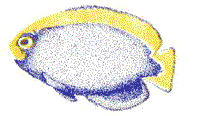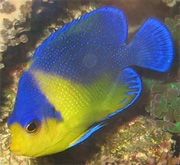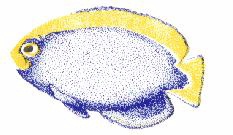|
Updated July 10, 2001
'It crept, it crawled, It took over the world'
OK, OK, so I am a little over dramatic, but have you read the book,
the statements, articles, and proposed legislation the local municipal
companies and California's assemblymen have written ? San Diego's Water
Quality Control Board hollers "Caulerpa taxifolia grows as a dense smothering
blanket, covering and killing all native aquatic vegetation in its path"
Oh no, lets all run for the hills !
I was originally drawn into this by a woman who contacted me seeking
information for a San Diego Scuba Diver Club article ( and I have never
heard from her since nor seen her article ). At the end of that telephone
conversation it had become appear ant to me that there was a tremendous
amount of 'dis-information' about this algae and the marine aquarium hobby.
Exploring this a bit further I found articles that described a family
of algae's called Caulerpa ( specifically a species called Taxifolia
) that had been introduced into a San Diego California community water
system. This algae, like the one introduced into the Mediterranean Sea,
had the potential, under the right conditions, to grow and spread. Since
this type of algae, which is non-native, or referred to as invasive, has
no natural local controls it could grow unrestricted in an alien environment.
The family of Caulerpa algae's are a form of 'macro', meaning large,
algae ( Kelp is a form of 'macro' algae ). Caulerpa species algae basically
consist of a branching, or creeping rhizomatom portion, called the stolon.
This main branching structure supports the rhizoids, which resemble roots
( hold fasts ), and blades ( leaves ). John
Rice's web site has a more specific description, as well as, a list
of the SEVENTY plus species of caulerpa's.
What was being done to control the spread of this algae in San Diego?
The answer varied depending on who you asked. According to Rachel Woodfield
of Merkel & Associates, a biological consulting firm in San Diego,
"who developed and implemented a plan to treat the seaweed" by covering
each patch of the algae with a heavy plastic tarp that was sealed
to the bottom at the edges and fitted with a small 'port' on top that allowed
for the introduction of herbicide under the tarp".
One San Diegan aquarium author stated "the government is overreacting
as usual, toxically nuking the area... poisoned to prevent its spread...
spending millions of dollars". Julian Sprung, a very popular aquarium author,
offered this comment "there are heaps of publications about C. taxifolia,
mainly originating from one guy and his associates, the reports of it devastating
the Mediterranean and spreading like wildfire are gross exaggerations."
On march 27, 2001 California
Assemblyman Tom Harman, of the 67th District of California ( Orange
County ) introduced Bill #1334 into the California State Assembly
that would amend the Fish and Game Departments code that " Makes it unlawful
to sell, possess, import, transport, transfer, release alive in the state,
or give away without consideration the saltwater algae of the genus Caulerpa."
Assemblyman Harman specifically pointed the finger at aquarium hobbyist
saying "the problem occurs when people dispose of the contents of their
aquariums into estuaries or saltwater lagoons".
But wait.....Did you catch that ? Note the word Caluerpa ! Not one species
of algae, as is the specific problem, but the entire family of Caulerpa
! I was told that the 'scientists' were having a difficult time specifically
identifying C.taxifolia from C.mexicana, due to its similarity.
As a result Assemblyman Harman, and his scientists, have decided to broadly
list the entire family of Caulerpa's as problematic. Kind of a shotgun
approach to the problem !!!
At this point I was hesitant to get involved as politics is not something
I feel I am qualified for, nor do I understand how it works. I made a telephone
call to the Pet Industry Joint Advisory Counsel ( PIJAC ). They had been
fighting this alone and were in need of additional support. What they needed
was support from the hobbyists themselves. A grass-roots effort.
It was at that time that I posted a few messages within Compuserve's
Fish and Reef Forums. Shortly thereafter a few more individuals began to
spread the word but unfortunately on May 7, 2001 the bill passed
the California State Assembly by a vote of 78 to 0, and was on its way
to the California State Senate for committee assignment.
With new efforts being generated by a California livestock wholesaler
and others within the pet industry a large letter writing campaign had
begun. Aquarium hobbyists from all over the country began to send letters,
e-mails and faxes to Assemblyman Harman's office.
It is at this point that something quite unexpected occurred. Assemblyman
Harman's office re-wrote the bill.......even though it had already passed
the California Assembly and was residing within the California Senate.
The re-write of the bill was to specifically name which species of algae's
within the caulerpa family have the potential to be problematic. On June
21, 2001, Assemblyman Harman re-submitted, and the California State Senate
amended Bill
#1334 to apply specifically to the "salt water algae of the Caulerpa species:
taxifolia, cupressoides, mexicana, sertulariodes, floridana, ashmeadii,
racemosa, verticillata, and scapelliformis".
Why the change ?
In a telephone conversation I had today ( July 10, 2001 ) with Dave
Weaver, a legislative assistant to Tom Harman, he told me that they were
not aware of the size of the Caulerpa family of algae's, and they now realized
that not all seventy plus species were problematic.
Since the bill has passed the California State Assembly, and its
been amended in the California State Senate one must assume that it will
pass through the rest of the legislative process without any variation.
It's with great relief that I have been able to rewrite this article,
an article that has been instrumental in, and has a had positive spin for,
the marine aquarium hobby. It is also with unexpected pleasure that the
efforts of aquarium hobbyists across the country have provided insight
to our legislators, shaped our governments view of, and protected the hobby
that we enjoy so much.
Killer
Algae: Ecological Disaster or Media Hysteria ?
Algae
in the Reef Tank
PIJAC's
Pet-Alert
'Noxious
Seaweed'
Assemblyman
Tom Harmans Bill AB 1334 history
|











